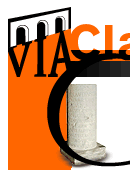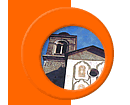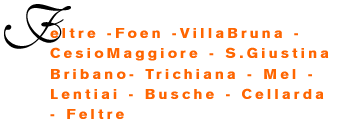|
According
to the hypothesis by Alpago Novello:
 the
route follows the mountain bike itinerary and therefore goes along
the Roman route backwards The Via Claudia Augusta may have reached
Cesio Minore and gone by Cesio Maggiore. From here towards Marsiai
and then to Formegan, on a crossroads between the Claudia Augusta
and a Roman trade route going from Feltre to Belluno (the meeting
point may have been the old church). From Formegan to Campo, the
route may have crossed diagonally the several pieces of ground where
excavations keep bringing to light archaeological relics such as
tombs and coins. After the stream Vesés, indicating, together with
the Terche stream, the boundaries of the two municipalities of Feltria
and Bellunum, the route goes by the present church of S. Marco,
known as "S.Marco di Via Pagana". Slightly southwards is the small
church of S. Lorenzo di Grigher (1393), considered in a neutral
territory in respect of Belluno and Feltre and therefore deputed
as place for the bishop's election of the two dioceses formerly
united. (After a long period of separation they are still today
ruled by the same diocese). The route towards Nave (the toponym
indicates a pontoon bridge to cross the Piave) leads then to Tiago,
crosses its centre, continues towards S.Donato (Longobard church)
and reaches the basin of the Zumelle Castle, whose structure certainly
presents Roman origin. the
route follows the mountain bike itinerary and therefore goes along
the Roman route backwards The Via Claudia Augusta may have reached
Cesio Minore and gone by Cesio Maggiore. From here towards Marsiai
and then to Formegan, on a crossroads between the Claudia Augusta
and a Roman trade route going from Feltre to Belluno (the meeting
point may have been the old church). From Formegan to Campo, the
route may have crossed diagonally the several pieces of ground where
excavations keep bringing to light archaeological relics such as
tombs and coins. After the stream Vesés, indicating, together with
the Terche stream, the boundaries of the two municipalities of Feltria
and Bellunum, the route goes by the present church of S. Marco,
known as "S.Marco di Via Pagana". Slightly southwards is the small
church of S. Lorenzo di Grigher (1393), considered in a neutral
territory in respect of Belluno and Feltre and therefore deputed
as place for the bishop's election of the two dioceses formerly
united. (After a long period of separation they are still today
ruled by the same diocese). The route towards Nave (the toponym
indicates a pontoon bridge to cross the Piave) leads then to Tiago,
crosses its centre, continues towards S.Donato (Longobard church)
and reaches the basin of the Zumelle Castle, whose structure certainly
presents Roman origin.
|
 |
According
to the hypothesis by
Luciano Bosio:
 oming
from the plain and after having gone by Falzè di Piave, the Via
may have continued along the left side of the Piave River and then
entered the valley. Going by Valdobbiadene it may have kept the
left side and have gone through Vas (it may have not passed through
the Zumelle Castle and Praderadego, as suggested by Alpago Novello).
The following route leads to Vas - Marziai - Busche - Cesiomaggiore
- Feltre - Artèn - Castel Tesino. oming
from the plain and after having gone by Falzè di Piave, the Via
may have continued along the left side of the Piave River and then
entered the valley. Going by Valdobbiadene it may have kept the
left side and have gone through Vas (it may have not passed through
the Zumelle Castle and Praderadego, as suggested by Alpago Novello).
The following route leads to Vas - Marziai - Busche - Cesiomaggiore
- Feltre - Artèn - Castel Tesino.

|







![]() Distance
Distance![]() Route
Route